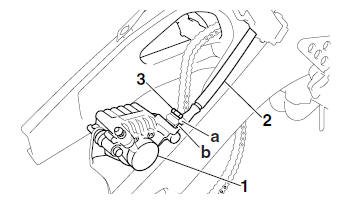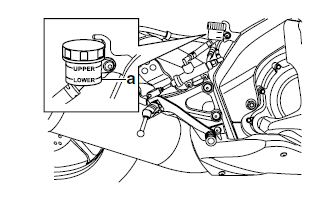Yamaha YZF-R125 Service Manual: Installing the rear brake caliper
1. Install:
- Brake caliper "1"

- Copper washers
- Brake hose "2"
- Union bolt "3"

| WARNING Proper brake hose routing is essential to insure safe vehicle operation. Refer to "CABLE ROUTING" on page 2-33. |
| CAUTION: When installing the brake hose onto the brake caliper, be sure to position the brake pipe "a" into the slot "b" in the brake caliper. |

2. Install:
- Brake pad spring
- Brake pads
- Brake pad retaining bolts
- Rear brake caliper
Refer to "REPLACING THE REAR BRAKE
PADS" on page 4-33.

3. Install:
- Rear wheel Refer to "REAR WHEEL" on page 4-12.
4. Fill:
- Brake fluid reservoir
(with the specified amount of the recommended
brake fluid)

WARNING
|
| CAUTION: Brake fluid may damage painted surfaces and plastic parts. Therefore, always clean up any spilt brake fluid immediately. |
5. Bleed:
- Brake system Refer to "BLEEDING THE HYDRAULIC BRAKE SYSTEM" on page 3-20.
6. Check:
- Brake fluid level
Below the minimum level mark "a"

Add the recommended brake fluid to the proper level.Refer to "CHECKING THE BRAKE FLUID LEVEL" on page 3-18.

7. Check:
- Brake pedal operation
Soft or spongy feeling
 Bleed
Bleed
the brake system.Refer to "BLEEDING THE HYDRAULIC BRAKE SYSTEM" on page 3-20.
 Assembling the rear brake caliper
Assembling the rear brake caliper
WARNING
Before installation, all internal brake components
should be cleaned and lubricated
with clean or new brake fluid.
Never use solvents on internal brake components
as ...
 Removing the rear brake master cylinder
Removing the rear brake master cylinder
NOTE:
Before removing the rear brake master cylinder,
drain the brake fluid from the entire brake system.
1. Disconnect:
Rear brake light switch coupler
2. Loosen:
Rear brake light switc ...
Other materials:
Checking the timing chain tensioner
1. Check:
Timing chain tensioner
Cracks/damage/rough movement Replace.
a. Lightly press the timing chain tensioner rod
into the timing chain tensioner housing by
hand.
NOTE:
While pressing the timing chain tensioner rod,
wind it clockwise with a thin screwdriver "1" until
it stops.
b. ...
Removing and installing the cowlings and panel
Removing and installing the cowlings and panel
Cowling A
Cowling B
Cowling C
Cowling D
Panel A
The cowlings and panel shown need to
be removed to perform some of the
maintenance jobs described in this
chapter. Refer to this section each time
a cowling or panel needs to be ...
Adjusting the drive chain slack
NOTE:
The drive chain slack must be checked at the
tightest point on the chain.
CAUTION:A drive chain that is too tight will
overload
the engine and other vital parts, and one that
is too loose can skip and damage the swingarm
or cause an accident. Therefore, keep
the drive ...
